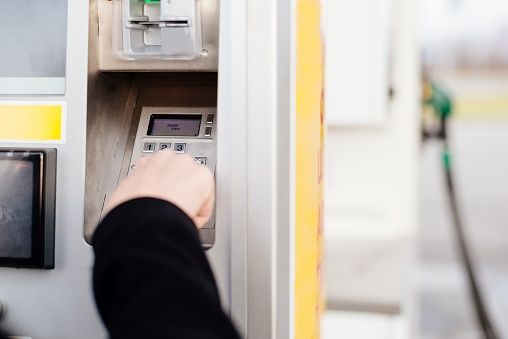
Every company that depends on fleet vehicles shares three basic needs — a method of payment for fuel, reliable expense tracking and comprehensive data reporting. Regarding payment, there are three options: cash, credit cards and fuel cards. Fuel cards offer improved expense tracking and reporting, making them an ideal choice for fleets.
With all the options, some can be riskier. Cash must be tracked manually and can be lost or stolen. Credit cards are more secure than cash but offer no real expense tracking or reporting features valuable for a business. Fuel cards, however, are more secure than cash while offering improved expense tracking and reporting, compared to credit cards.
Fuel cards offer a more detailed breakdown of fuel expenses when compared to cash or credit cards.
Before exploring the tracking and reporting capabilities of fuel cards compared to credit cards or cash, let’s look at a fuel card’s basic functions.
What is a Fuel Card?
Fuel cards, also known as fleet cards, fleet fuel cards or corporate gas cards, are used specifically for purchasing fuel and paying for vehicle-related expenses. Often, these cards offer fuel rebates or discounts as well as savings on vehicle-related purchases like tires or parts and services. These savings alone can make fleet cards a great payment option. However, there are many other reasons to use a fleet fuel card for fuel purchases.
Advantages of Fuel Cards Over Cash or Credit Cards
Fuel Expense Tracking and Fuel Cards
With cash purchases, every receipt must be kept, and every detail manually entered into a spreadsheet or other tracking tool. Credit cards give you purchase data on monthly statements, but the details are limited. With fleet cards, you can access all your purchase info in real time. In addition, fleet cards have tracking information pertaining to drivers and vehicles, as well as purchase controls and additional security.
Enhanced Expense Tracking
Fuel cards offer a more detailed breakdown of fuel expenses when compared to cash or credit cards. Each fuel card transaction is logged in a fleet card dashboard as the purchases happen, tracking the following details:
- Date and time of purchase
- Location of purchase
- Volume of fuel purchased
- Dollar amount of purchase
- Fuel type and grade purchased
Real-time monitoring of fuel transactions creates transparency around fuel spend. With this data, businesses can stay informed about fuel consumption and make data-driven decisions. Remember, when using a fuel card, all fuel expense tracking is automatic.
Payment Controls
Fuel cards allow fleet managers or business owners to set limits and payment controls on purchases. While not directly related to expense tracking, these payment controls impact how and what information is monitored. Standard purchase limits include:
- Fuel type (gas vs. diesel)
- Fuel grade
- Volume (gallons)
- Time of day or days of the week
- Specific fuel stations
- Number of transactions in a given timeframe
Purchase limits are something cash and credit cards can’t deliver. The benefit of these limits is managers can define what and how their purchases are tracked. These purchase limits also help control misuse of funds by ensuring employees use fuel resources responsibly.
Security and Fraud Prevention

In addition to purchase controls, many fleet card providers monitor suspicious activity in real time and alert fleet managers. Additionally, fuel cards are equipped with personal identification numbers (PINs). These PINs must be entered at the pump before a transaction can proceed. In the case of theft or a lost card, managers can quickly and easily deactivate cards to prevent unauthorized usage.
None of these features are available with cash, and some basic credit cards can be more susceptible to misuse or fraud than fleet cards.
Fuel Expense Reporting and Fuel Cards
With cash or credit cards, you must rely on manual reporting, which creates enormous room for human error. With a fuel card, however, you have powerful reporting at your fingertips, and the reporting power reduces the administrative load for your accounting team.
Streamlined Reporting
Fuel cards automate the reporting process, saving hours of manual data entry and analysis. Reports can be customized based on your business needs. You can easily create reports showing driver, vehicle or department expenses. Since data is directly transferred from your fleet card to the dashboard where your reports are created, there is less risk of human error when compared with manual credit card or cash reporting.
Automated reports make it easy to identify trends, inefficiencies or outliers in fuel consumption. These valuable insights into fuel spending patterns enable businesses to identify areas for cost reduction.
Automated reports make it easy to identify trends, inefficiencies or outliers in fuel consumption.
Reduced Administrative Load
Because of the reporting features of fuel cards, there is no need for drivers to submit expense reports, a very labor intensive process still required when using cash or credit cards. With fleet cards, your accounting department has more time to help grow your business.
The time saved in collecting and collating receipts, cross-checking expense claims, and processing reimbursements can instead be invested in more strategic tasks.
Free Up Time with Better Tracking and Reporting
While there are several payment options for fleets, a fuel card can help your business run more efficiently. You can save time, have accurate, real-time data and have access to enhanced, thorough reports and data analytics.
Fuel cards are changing the way businesses manage their fuel expenses. Is it time for you to discover the fuel card advantage?
Learn more here.